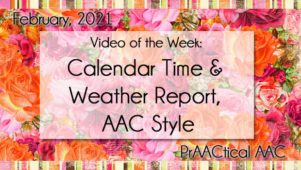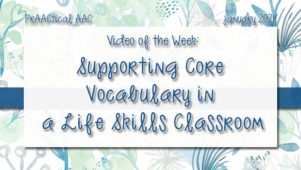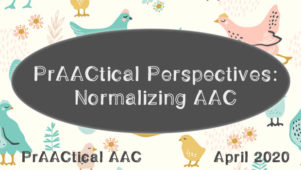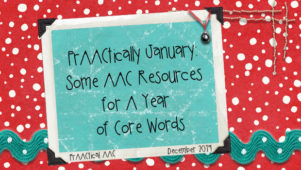How I Do It: A Year of Core Words in Action
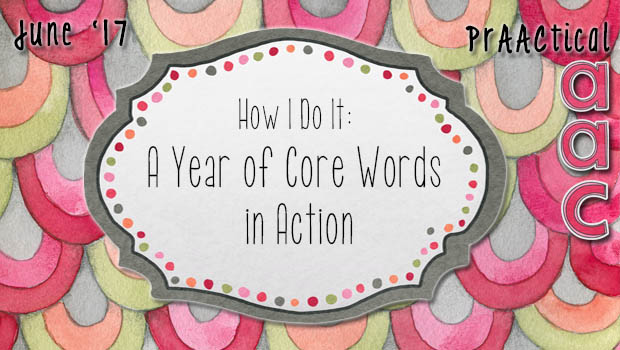
Some of the best resources are the ones that we can modify to use in ways that fit our own specific needs. In this post, SLP Kim Hurley, a graduate of Indiana University, shares her experiences in experimenting with the Year of Core Vocabulary approach. Kim has spent the past 15 years as a specialist for students with moderate and severe disabilities or complex communication needs in educational settings. Currently, she is employed by Forest Hills Special Education Cooperative, serving students in rural Monroe and Owen Counties in south central Indiana. Enjoy!
disabilities or complex communication needs in educational settings. Currently, she is employed by Forest Hills Special Education Cooperative, serving students in rural Monroe and Owen Counties in south central Indiana. Enjoy!
::::::::::::::::::::::::::::::::::::::::::::::::::::::::::::::::::::::::::::::::
For the past 15 years, I have been working as an SLP serving public school students who have moderate to severe disabilities or complex communication needs. Several students benefit from various forms of augmentative communication, and in my years of work I have come to appreciate the flexibility that a robust, core word based system provides. However, when starting out with a student, sometimes it is easy to get lost in ‘all the words’ and forget that expressive vocabulary learning is a critical piece of communication success.
For all of my students, I begin with a basic assumption that some sort of core word based system will provide the individual with the best opportunity to communicate a variety of messages (requests, comments, inquiries, exclamations, etc.). But what is ‘core vocabulary’?. A quick Google search provides a simple, elegant definition: Core vocabulary is a small set of simple words, in any language, that are used frequently and across contexts (Cross, Baker, Klotz, & Badman, 1997).
Giving students core vocabulary, however, is just the start. There is no guarantee that the student understands HOW to use these words, even though they have heard them and appear to understand others’ use of them. Learning to use core vocabulary means not only comprehending the words, but understanding HOW to use them as well as WHERE to find them on the device.
An additional struggle arises when we realize that core vocabulary is not easily represented. These are not, for the most part, nouns or specific verbs. Instead, these are multi-purpose words, articles, carrier verbs. Instead, teaching needs to focus on consistent use and motor planning. Typical children develop speech by watching, listening, and hearing others use words in various contexts long before attempting to use words. Similarly, AAC users benefit from seeing communication partners use the same ‘language’ to communicate. As we model words, our students see how we use the words at the same time that they observe where to find those words. It seems simple, but when asking a busy classroom teacher or overworked paraeducator to use this technique, it is not uncommon to hear them say ‘I don’t have time’ or ‘It’s too much to learn.’
So how can we, as speech and language professionals, address these concerns? How do we teach these core words? How do we encourage modeling? How can we make the best use of a robust vocabulary when given minimal resources?
I personally pondered all these questions when I realized my own student was not making the progress I expected. Princess received a PRC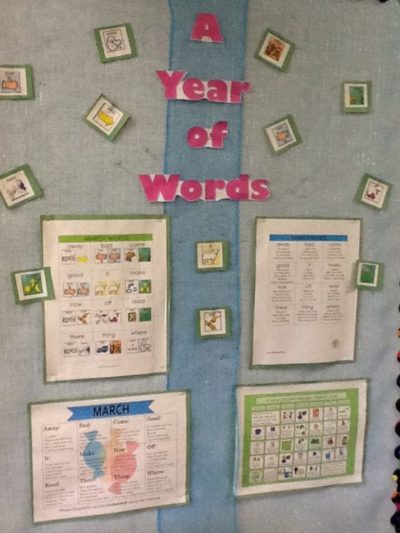 Vantage Light device when she was in kindergarten. After just a few months, she was using the full 85-Sequenced Unity vocabulary in our sessions with me. She was able to produce simple sentences such as “She is walking” to describe pictures, and she played a mean game of Go Fish (“Do you have this?” was a lightning fast sequence for her). When she reached 4th grade, however, her inclusion teacher queried me about her expressive language skills. It turns out we had a problem: Princess was able to do what I asked her to do in our structured therapy sessions, but had not carried over her skills into the classroom. Additionally, Princess had significant difficulty constructing novel messages to talk about things she had done, seen, or read. While she could ask “Do you have this?”, she could not construct a different phrase or sentence using the same words (“I have this”, “I do”, etc.) without a model.
Vantage Light device when she was in kindergarten. After just a few months, she was using the full 85-Sequenced Unity vocabulary in our sessions with me. She was able to produce simple sentences such as “She is walking” to describe pictures, and she played a mean game of Go Fish (“Do you have this?” was a lightning fast sequence for her). When she reached 4th grade, however, her inclusion teacher queried me about her expressive language skills. It turns out we had a problem: Princess was able to do what I asked her to do in our structured therapy sessions, but had not carried over her skills into the classroom. Additionally, Princess had significant difficulty constructing novel messages to talk about things she had done, seen, or read. While she could ask “Do you have this?”, she could not construct a different phrase or sentence using the same words (“I have this”, “I do”, etc.) without a model.
After some probing, I realized that Princess had a good grasp of a few phrases and specific nouns, but was not able to independently use core words to construct meaningful messages. At the same time, her inclusion teachers were interested in increasing her sight word recognition using Dolch sight word lists. As I looked at these concerns, I had a small ‘aha’ moment – PrAACtical AAC’s “A Year of (Core) Words”. I remembered reading about the lists and thinking that it was a good idea, but had not been able to implement structured teaching with my students with any success. Maybe it was time to revisit. At the same time, I came across a blog post from Speechy Musings (October 13, 2015) – “Increasing AAC Core Vocabulary Carryover”. Soon, a plan was forming – I would use the PrAACtical AAC lists (which shared many words with the Dolch sight word lists) and the strategies suggested in the Speechy Musings blog to address Princess’s vocabulary and language deficits.
Initially, Princess was a bit reluctant to buy in. Tangible rewards (aka bribes) helped to ease some of the doubt, and we started out slowly. I 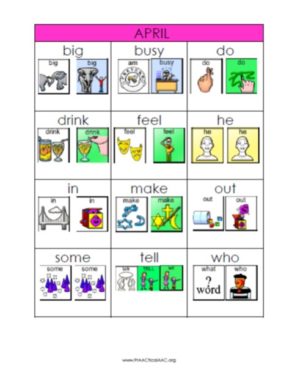 gave Princess as much control as I could, allowing her to choose which words to target each week (we started at 3 words each week, but some weeks we would work on up to 6 words). Once we selected the words, I would follow a fairly structured teaching plan: practice retrieving (5-10 times per word to build motor memory), modeling the word in phrases or sentences, cloze sentences to elicit retrieval, and then a ‘fun’ activity. Princess didn’t always appreciate some of my ‘fun’ activities – she didn’t care for creating her own ‘books’ illustrating core words, but she did like to play Go Fish! Once we had completed a month, I added in a challenge activity and asked Princess to make up her own phrases or sentences using the core words we had learned.
gave Princess as much control as I could, allowing her to choose which words to target each week (we started at 3 words each week, but some weeks we would work on up to 6 words). Once we selected the words, I would follow a fairly structured teaching plan: practice retrieving (5-10 times per word to build motor memory), modeling the word in phrases or sentences, cloze sentences to elicit retrieval, and then a ‘fun’ activity. Princess didn’t always appreciate some of my ‘fun’ activities – she didn’t care for creating her own ‘books’ illustrating core words, but she did like to play Go Fish! Once we had completed a month, I added in a challenge activity and asked Princess to make up her own phrases or sentences using the core words we had learned.
To encourage carryover, I would tape the ‘words of the week’ to the back of Princess’s device (each word had an illustration for retrieval so that she could practice on her own). I would also send out an email to her teachers explaining the words, providing instructions for retrieval, and giving them ideas for eliciting these words in the classroom. Because Princess spent much of her day in an inclusive classroom without paraeducator support, I felt it was most important that I informed teachers Bu I did not expect much modeling.
Since services for Princess were limited to the academic school year, it has taken over a year to complete the first 12 months. Nevertheless, Princess has demonstrated visible growth in her ability to construct novel messages, describe pictures, and use core vocabulary to provide meaningful interactions. In reviewing her progress this May, I determined that at the initiation of the project, Princess had knowledge of 7 “A Year of (Core) Words” words; this May, she was able to demonstrate knowledge of 85 of the 114 words we studied – that is, she could independently retrieve the word and use it appropriately in a phrase or sentence.
Princess isn’t done learning; she continues to struggle with expressive language outside of therapy, but now she is armed with enough words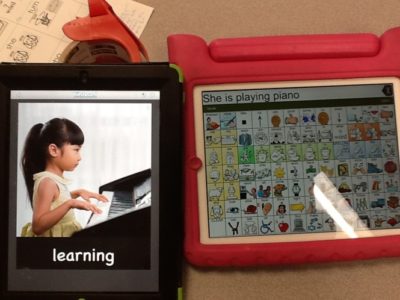 that she can at least attempt to express some basic information to peers and teachers throughout the school setting. In addition, she is gaining confidence with reading and writing tasks. Princess also participates in a small AAC group with another device user, and is delighted when she can show him where to find specific vocabulary terms.
that she can at least attempt to express some basic information to peers and teachers throughout the school setting. In addition, she is gaining confidence with reading and writing tasks. Princess also participates in a small AAC group with another device user, and is delighted when she can show him where to find specific vocabulary terms.
The PrAACtical AAC “A Year of Core Words” list has been a valuable tool to help me structure my own vocabulary instruction for my AAC device user. I have also begun working on some group-based activities with these word sets, and next school year I will be conducting some language ‘fun’ groups in the self-contained classrooms I serve. I’m looking forward to expanding my ability to teach core vocabulary in a structured and thoughtful manner. I am incredibly grateful for finding the PrAACtical AAC lists (as well as additional resources), as I know have a structure for teaching, and a clear plan for addressing how to teach meaningful use of high frequency words that will allow my students to increase their functional communication skills.
You can download Kim’s PowerPoint presentation on her experiences here.
Filed under: Featured Posts, PrAACtical Thinking
Tagged With: classroom, Year of Core Words
This post was written by Carole Zangari

